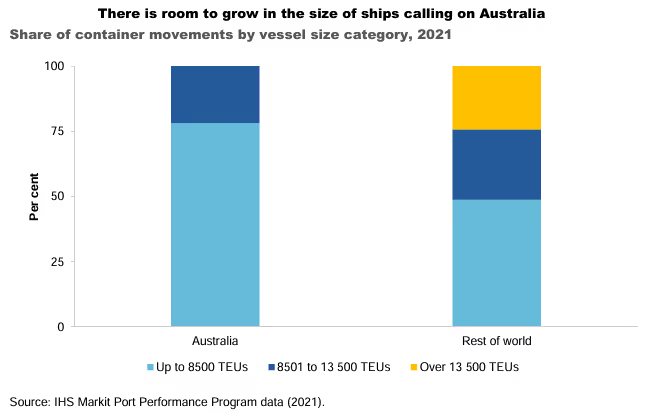

The increasing size of container ships poses a significant challenge for the maritime logistics system. While larger vessels may offer reduced costs for long-haul ocean transport, they also necessitate substantial investments in port infrastructure to accommodate their massive scale. Deeper and wider shipping channels, more efficient cranes, and enhanced landside infrastructure are essential to support the efficient handling of these giant vessels. Furthermore, the concentration of cargo on fewer, larger ships heightens the risk of accidents and disruptions, underscoring the need for proactive risk management strategies.
Despite these complexities, Australia's container port operators and other stakeholders have to demonstrate a commitment to upgrading infrastructure to support the growing demands of larger container ships. As the nation's freight task continues to expand, driven by growth in the global shipping fleet, these investments are not only mandatory but absolutely vital,to that Australia's ports remain competitive and efficient in the face of evolving maritime logistics demands.

The container shipping industry has witnessed a steady trend towards the use of larger vessels over the past half-century. Since the maiden voyage of the SS Ideal X, widely regarded as the world's first container ship, in 1956, ships have undergone significant transformations to carry more containers. They have become longer, wider, taller, and deeper, with the SS Ideal X's 160-meter length, 9-meter width, and 58-container capacity giving way to modern behemoths like the Ever Ace.
The Ever Ace, launched in April 2022, is a staggering 400 meters long, 62 meters wide, and can carry up to nearly 24,000 twenty-foot equivalent units (TEU). This trend towards bigger ships has sparked recurring debates about the need for port capacity investments to accommodate them. Two decades ago, industry commentators questioned whether terminals could cope with 9,000 TEU ships; today, the same concerns are being raised as ships approach and exceed 24,000 TEU.
Interestingly, container ships visiting Australia tend to be smaller than their global counterparts, indicating potential for ongoing increases in ship size. In 2021, less than 50% of global container movements involved ships with capacities up to 8,500 TEU, whereas these smaller vessels accounted for nearly 80% of container movements in and out of Australia. Conversely, ships with capacities exceeding 13,500 TEU, which did not visit Australia, accounted for a quarter of global container movements.

As port operators worldwide contemplate investments to accommodate 24,000 TEU vessels, Australian port operators are focusing on accommodating 14,000 TEU ships, which are smaller than the most popular ships currently on order. When new, larger vessels are introduced on high-volume shipping routes, older, smaller vessels are often "cascaded" to service lower-volume destinations like Australia.
While the increasing size of container ships has significant implications for the maritime logistics system, the fact that ships have grown larger suggests that they have yielded net benefits for the system's users, including importers and exporters. The benefits and costs of larger ships are largely reflected in prices for port services, stevedoring, and other related services. However, the use of bigger ships can also have unpriced effects that may create a disparity between the net benefits to users of the maritime logistics system and the broader community.
Interestingly, one of the most significant unpriced effects of larger ships is the reduction of carbon emissions, which actually enhances the overall benefits of using bigger ships.
Australia's ports are at a critical juncture, with the increasing size of container ships driving the need for infrastructure upgrades. As the nation's freight task continues to grow, it is essential that we explore innovative funding solutions to support port expansions. To encourage private sector investment in port infrastructure, governments must send clear signals about what projects warrant taxpayer funding. If port operators believe that taxpayer funding may be available, they may delay investing in upgrades, hoping that taxpayers will foot the bill.
Instead, governments should focus on creating an environment that fosters private sector investment and innovation. This can be achieved by providing regulatory certainty, streamlining approval processes, and encouraging collaboration between industry stakeholders. By leveraging private sector investment and expertise, we can ensure that Australia's ports remain competitive, efficient, and sustainable, supporting the nation's economic growth and development for generations to come.





-min.webp)
-min.webp)
-min.webp)

